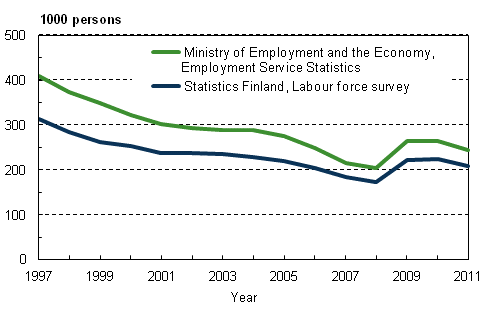Comparison between the statistics of Statistics Finland and the Ministry of Employment and the Economy
The figures on unemployment in Statistics Finland's Labour Force Survey and in the Employment Service Statistics of the Ministry of Employment and the Economy have always deviated from each other. In recent years, the annual number of unemployed persons has been some 31,000 to 44,000 lower in the Labour Force Survey than in the Employment Service Statistics (Figure). The main reason why the numbers of unemployed persons deviate is that an unemployed person is defined differently in the two sets of statistics because their points of departure and the needs of their users differ.
Unemployed persons in the statistics of Statistics Finland and the Ministry of Employment and the Economy in 1997–2011

Statistics Finland's Labour Force Survey describes the demand and supply of labour in the economy and the measurement of unemployment is just one of the Survey's tasks. The Labour Force Survey is based on a sample drawn from the population aged 15 to 74. In the Labour Force Survey, the definitions for an employed and an unemployed person comply with the recommendations of the ILO, the International Labour Organisation of the UN, and the regulations of the European Union. The figures are internationally comparable.
The Employment Service Statistics of the Ministry of Employment and the Economy, in turn, register job seekers visiting the employment and economic development offices and they are intended for the needs of employment placement activities and employment administration. The Employment Service Statistics are used in the targeting of labour policy measures and in the monitoring of their effects. The figures on unemployment in the Employment Service Statistics cannot be internationally compared because the labour force administrations and legislations on unemployment benefits vary by country.
In Statistics Finland's Labour Force Survey, a person is unemployed if he/she is without work during the survey week (has not done paid work or has not worked as self-employed), has actively sought work as an employee or self-employed in the past four weeks and could start work within two weeks. A person who is without work and waiting for an agreed job to start within three months is also classified as unemployed if he/she could start work within two weeks. Students and persons temporarily laid off from work who meet the above criteria are also classified as unemployed.
In the Employment Service Statistics of the Ministry of Employment and the Economy, the criteria on an unemployed person are not as strict as in Statistics Finland's Labour Force Survey. In the Employment Service Statistics an unemployed person is a job seeker who is without work and is available for work in which the number of working hours is at least half of the normal hours in the field or who is waiting for agreed work to start. Temporarily laid off persons having reported as job seekers are also classified as unemployed persons in the Employment Service Statistics. The Employment Service Statistics do not classify as unemployed the recipients of unemployment pension or full-time students - not even during school holidays. In practice, the Employment Service Statistics cover the unemployed persons who receive unemployment benefit.
Disguised unemployment explains some of the differences between the figures of Statistics Finland and the Ministry of Employment and the Economy. Persons outside the labour force who would want gainful work and would be available for work within a fortnight, but who have not actively looked for work in the past four weeks are classified as persons in disguised unemployment in the Labour Force Survey. In 2011, the average number of persons in disguised unemployment was 103,000. The reasons for disguised unemployment could be giving up job seeking or other reasons, such as studying, looking after children or heath reasons.
Unemployment also shows considerable seasonal variation in the Labour Force Survey. In the Labour Force Survey, unemployment rises temporarily in spring and has been regularly higher than the spring figures on unemployment in the Employment Service Statistics. This is explained by students looking for work at term-ends. For example, in May 2012 the number of unemployed persons in the Labour Force Survey was 266,000 while the respective number in the Employment Service Statistics was 229,000 persons. The share of students of the number of the unemployed in the Labour Force Survey was 45 per cent. Students are not entered as unemployed job seekers in the Employment Service Statistics. In all other months, the number of unemployed persons has been considerably higher in the Employment Service Statistics than in the Labour Force Survey.
Internationally comparable figures corresponding with those from Statistics Finland's Labour Force Survey, as well as national unemployment figures based on administrative data sources, which can deviate considerably from each other, are also published in other EU countries.
Last updated 5.11.2012
Official Statistics of Finland (OSF):
Labour force survey [e-publication].
ISSN=1798-7857. Helsinki: Statistics Finland [referred: 5.12.2025].
Access method: http://stat.fi/til/tyti/tyti_2012-11-05_men_002_en.html

